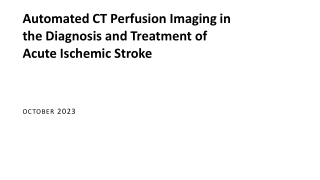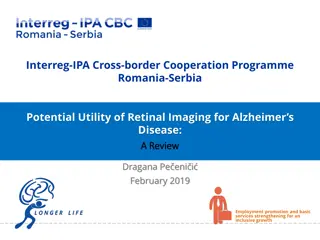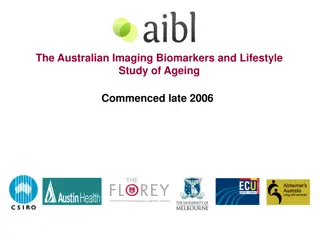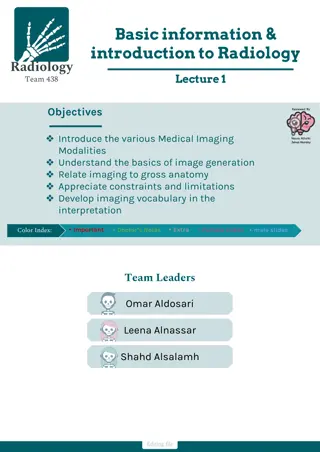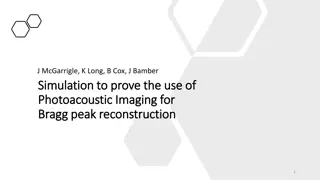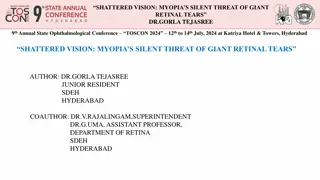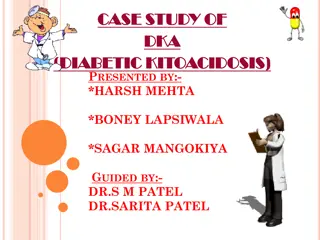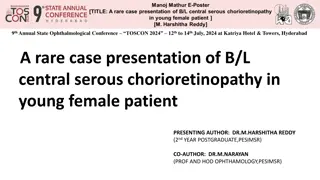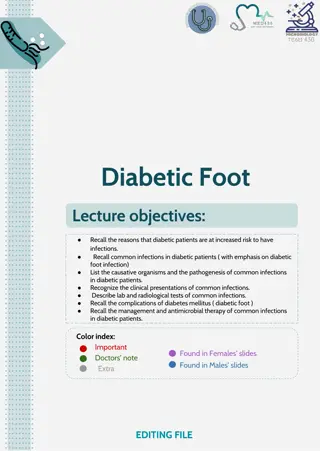Retinal Imaging Conference - Case Study of Diabetic Patient with Blurry Vision
A 52-year-old African American female with a history of diabetes and hypertension presented with occasional blurry vision in her left eye. Examination revealed retinal thickening, cystic spaces, and disruption of retinal layers. Autofluorescence imaging showed hyperautofluorescence centrally and hypoautofluorescence superiorly. Fluorescein angiography indicated delayed venous arcade filling with areas of hypofluorescence and hyperfluorescence. The case underscores the importance of regular diabetic eye exams for early detection of retinal changes.
Download Presentation

Please find below an Image/Link to download the presentation.
The content on the website is provided AS IS for your information and personal use only. It may not be sold, licensed, or shared on other websites without obtaining consent from the author.If you encounter any issues during the download, it is possible that the publisher has removed the file from their server.
You are allowed to download the files provided on this website for personal or commercial use, subject to the condition that they are used lawfully. All files are the property of their respective owners.
The content on the website is provided AS IS for your information and personal use only. It may not be sold, licensed, or shared on other websites without obtaining consent from the author.
E N D
Presentation Transcript
Retinal Imaging Conference Shivani V. Reddy, MD University of Louisville Department of Ophthalmology and Visual Sciences 6/5/2014
Patient Presentation CC: Blurry vision OS x 1month HPI: 52 y/o AAF presenting to the eye clinic for her first diabetic exam c/o occasional blurry vision OS x 1 month. Denies flashes, floaters, scotomas or episodes of vision loss.
Medical History POHx: none PMH: DMII (diagnosed 3 months prior, A1c: 8.9%) HTN with HTN urgency episode in 2012 secondary to cocaine abuse Meds: Allergies: metformin, lantus insulin, norvasc, gabapentin NKDA
Exam 14 20/20-1 (sc) 3 ->2mm (-) RAPD BCVA P TTP 17 3 ->2mm 20/60-2 (-1.00+1.00x180) EOM: CVF: Full OU Full OU Anterior Segment: mild NS cataracts OU, otherwise WNL
OCT OD OS OS: retinal thickening with cystic spaces temporal to fovea, subfoveal disruption of ELM and ellipsoid region lines
Autofluorescence OS OD: Area of central hyperautofluorescence , hypoautofluorescense concentrated superiorly
FA Photo OS 00:19:53 Arterial phase : normal arterial filling
FA Photo OS 00:23:28 Mid AV phase : delayed superotemporal venous arcade filling, scattered areas of hypofluorescence, pinpoint hyperfluorescent areas
FA Photo OS 00:30:33 Late AV phase: persistent filling defect in superior temporal arcade, prominent macular collateral vessel, hypofluoresent ares scattered throughout the sup-temp segment
FA Photo OS 00:38:65 Venous Phase: Late filling of superotemporal venous arcade, increasing hyperfluorescence surrounding original pinpoint areas with persistent intervening hypofluorescent regions, hyperfluorescence temporal to the fovea, appearance of venous collaterals
FA Photo OS 01:44:39 Recirculation phase: increasing hyperfluoresnce around pinpoint leakages, decreasing fluorescence of collateral vessels. Increasing hyperfluorescence temporal and superior to the fovea
FA Photo OS 02:24:13 02:39:10
Assessment and Plan A: 52 yo AAF with CME OS secondary to old branch retinal vein occlusion. P: Avastin OS, follow-up pending
Branch Retinal Vein Occlusion Vein occlusion that occurs most commonly at an AV crossing Mean age of presentation: 7th decade Risk factors HTN Cardiovascular disease Glaucoma history Increased BMI at age 20 Most commonly effected area: supero-temporal quadrant
Branch Retinal Vein Occlusion Acute Phase Segmental intraretinal hemorrhage with apex near obstructed vein Subretinal hemorrhages less common Cotton wool spots scattered throughout the occluded segment CME with layering intraretinal heme within the cysts If CME present, round yellow spot can occur centrally that later disappears
Branch Retinal Vein Occlusion Chronic Phase Resolution of subretinal heme at 9-12 months Underlying retinal vascular abnormalities seen on FA Collateral vessel formation around blockage site Capillary telangiectasia Capillary non-perfusion areas within involved segment
Branch Retinal Vein Occlusion Branch Vein Occlusion Study (BVOS) Questions asked: Can scatter laser prevent neovascularization? Can peripheral scatter laser prevent vitreous hemorrhage?. Can grid laser improve visual acuity in eyes with macular edema with vision <20/40? Conclusions: Grid laser is beneficial for macular edema with vision <20/40 for 3 months Scatter laser is beneficial for prevention of vitreous hemorrhage The Branch Vein Occlusion Study Group. Argon laser photocoagulation for macular edema in branch vein occlusion. Am J Ophthalmol. 1984;98(3):271-282.2001;21:416-434.
Branch Retinal Vein Occlusion SCORE (BRVO) Study Question asked: Is triamcinolone beneficial in the treatment of macular edema when compared to standard of care? Patients were divided into 3 groups: grid laser, 4mg , 1mg group. Visual acuity changes were compared at 1 year Conclusions: 3 groups with similar VA improvement BUT more complications in the steroid group. Therefore, Grid laser was the benchmark against which future treatments should be compared Scott IU, Ip MS, Van Veldhuisen PC, et al; SCORE Study Research Group. A randomized trial comparing the efficacy and safety of intravitreal triamcinolone with standard care to treat vision loss associated with macular edema secondary to branch retinal vein occlusion: the Standard Care vs Corticosteroid for Retinal Vein Occlusion (SCORE) study report 6. Arch Ophthalmol. 2009;127(9):1115-1128.
Branch Retinal Vein Occlusion BRAVO Study Purpose: to determine the safety and efficacy of Lucentis in treating macular edema Design: 3 groups 0.3mg , 0.5mg ranibizumab and sham Patients received monthly injections Number of patients with >15 letters gained at 6 months: 0.5mg group: 61.1%, 0.3mg group: 55.2%, sham group: 28.8% Conclusion: Intravitreal ranibizumab is effective for treatment of macular edema following BRVO Campochiaro PA, heier JS, Feiner L, et al; BRAVO Investigators. Ranibizumab for macular edema following branch retinal vein occlusion: six- month primary end point results of a phase III study. Ophthalmology. 2010;117(6):1102-1112.
Branch Retinal Vein Occlusion GENEVA Study Purpose: to evaluate the efficacy and safety of Ozurdex for visual loss secondary to macular edema associated with BRVO Design: patient injected with intravitreal implant 0.7mg, 0.35mg or sham Conclusion: Dexamethasone intravitreal implant can reduce the risk of vision loss and improve speed and incidence of visual improvement Haller JA, Bandello F, Belfort R Jr, et al; OZURDEX GENEVA Study Group. Randomized, sham-controlled trial of dexamethasone intravitreal implant in patients with macular edema due to retinal vein occlusion. Ophthalmology. 2010;117(6):1134-1146.Epub 2010 Apr 24.
Dexamethasone implant for macular edema secondary Dexamethasone implant for macular edema secondary to ischemic retinal vein occlusion to ischemic retinal vein occlusion Francesco Bandello, University of Vita-Salute, Scientific Institute San Raffaele Pierluigi Iacono, Fondazione GB Bietti, Roma Maurizio Parodi Macula Society, 2014 Purpose: to evaluate the effects of dexamethsone implant for the treatment of macular edema secondary to ischemic retinal vein occlusions over a 12 month follow-up Methods: - prospective, open-label, interventional, case series. - each patient received a comprehensive exam, FA & OCT imaging followed by a dexamethasone implant - retreatment based on presence of macular edema at month 4 primary outcome measure: ETDRS letter score secondary outcome measure: CME, number of injections during followup
Dexamethasone implant for macular edema secondary Dexamethasone implant for macular edema secondary to ischemic retinal vein occlusion to ischemic retinal vein occlusion Francesco Bandello, University of Vita-Salute, Scientific Institute San Raffaele Pierluigi Iacono, Fondazione GB Bietti, Roma Maurizio Parodi Macula Society 2014 Results: 24 patients enrolled (11 CRVO, 13 BRVO) - mean ETDRS letter score changed: BRVO 75,3 to 95,6 CRVO 44,3 to 60,8 - CMT change BRVO 544um to 321um CRVO 776um to 444um - mean #injections BRVO: 1.7 CRVO: 1.8 Conclusions: Dexamethasone implant reduces ME in eyes with ischemic RVO s, leading to a slight visual acuity improvement
The OMAR study: Comparison of Ozurdex and Triamcinolone Acetonide for Refractory Cystoid Macular Edema in Retinal Vein Occlusion Ahmet Ozkok, M.D.,*Omar A Saleh, M.D.,* Douglas K. Sigford, M.D.James W Heroman, M.D. Shlomit Schaal, M.D., Ph.D. Purpose: To compare the risks and benefits of adding either intravitreal dexamethasone implant (DEX) or preservative free triamcinolone acetonide (TA) to bevacizumab monotherapy in refractory CME due to RVO Design: interventional, comparative study of 74 patients received bevacizumab, then later DEX (35) and TA (39) outcome measures: BCVA, CMT, frequency of injections Results: no significant change in BCVA significant improvement in CMT significant decrease in number of injections per month, more so in DEX group (from 0.66 to 0.26 inj/mo)
References Retina-Vitreous Macula. Guyer, Yannuzzi, Chang, Shields, Green BCSC. Chapter 12 Retina and Vitreous. 2012-2013:Chapter 6:121-127. The Branch Vein Occlusion Study Group. Argon laser photocoagulation for macular edema in branch vein occlusion. Am J Ophthalmol. 1984;98(3):271-282.2001;21:416-434. Scott IU, Ip MS, Van Veldhuisen PC, et al; SCORE Study Research Group. A randomized trial comparing the efficacy and safety of intravitreal triamcinolone with standard care to treat vision loss associated with macular edema secondary to branch retinal vein occlusion: the Standard Care vs Corticosteroid for Retinal Vein Occlusion (SCORE) study report 6. Arch Ophthalmol. 2009;127(9):1115-1128. Haller JA, Bandello F, Belfort R Jr, et al; OZURDEX GENEVA Study Group. Randomized, sham-controlled trial of dexamethasone intravitreal implant in patients with macular edema due to retinal vein occlusion. Ophthalmology. 2010;117(6):1134-1146.Epub 2010 Apr 24. Campochiaro PA, heier JS, Feiner L, et al; BRAVO Investigators. Ranibizumab for macular edema following branch retinal vein occlusion: six-month primary end point results of a phase III study. Ophthalmology. 2010;117(6):1102-1112. The Eye Disease Case-control Study Group. Risk factors for branch retinal vein occlusion. Am J Ophthalmol 1993;116(3):286- 96.


